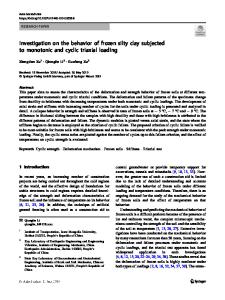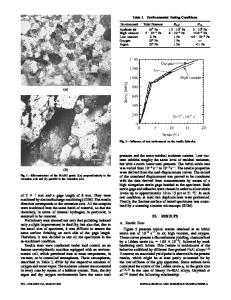Mathematical Modeling of the Monotonic and Cyclic Loading Processes
- PDF / 336,991 Bytes
- 8 Pages / 594 x 792 pts Page_size
- 51 Downloads / 333 Views
MATHEMATICAL MODELING OF THE MONOTONIC AND CYCLIC LOADING PROCESSES V. S. Bondar1 and D. R. Abashev
UDC 539.374
Based on experimental studies of specimens of 12Kh18N10T stainless steel under a rigid (straincontrolled) deformation process, which includes a sequence of monotonic and cyclic loading modes, some features and differences between isotropic and anisotropic hardening under monotonic and cyclic loading are found. To describe these features in terms of the theory of plasticity (the Bondar model), the criterion of change of plastic deformation direction and a memory surface are introduced in the space of the plastic strain tensor, which allow one to separate the processes of monotonic and cyclic loading. To describe the transitional processes, evolutionary equations for isotropic and anisotropic hardening parameters are formulated. The change in the stress-strain state during monotonic and cyclic loading, obtained by calculation and experiment, is compared. Keywords: monotonic and cyclic loading, plasticity theory, memory surface, basic experiment, identification method. Introduction. Non-stationary and asymmetric processes of cyclic deformation include a sequence of monotonic and cyclic loading modes. Mathematical modeling of such a process under conditions of rigid (strain-controlled) and especially soft (stress-controlled) loading is a very difficult task. Furthermore, when these modes are implemented, the processes of fitting and ratcheting of a hysteresis loop, which are difficult to describe, arise. As for the assessment and prediction of the resource under unsteady and asymmetric cyclic loading conditions, the damage accumulation in these cases should be defined during the loading process, taking into account that the damage accumulation is significantly non-linear. Mathematical modeling of deformation and damage accumulation under cyclic loading is based mainly on versions of plasticity theories, which belong to the class of plastic flow theories with combined (isotropic and anisotropic) hardening [1–12]. In the present work, the mathematical modeling of deformation and damage accumulation is based on such a version of plasticity theory as the Bondar model [1–3, 9], which, as shown earlier in [10], is the most adequate for describing deformation and fracture under cyclic loading compared to the Korotkikh [4] and the Chaboche [6–8] models. The basic equations of the Bondar model are given below. To identify deformation features under non-stationary and asymmetric cyclic loading, rigid loading under tension-compression conditions of 12Kh18N10T stainless steel specimens, which consists of five stages, i.e., cyclic, monotonic, cyclic, monotonic, and cyclic up to fracture, is considered. Analysis of transient processes from cyclic to monotonic and from monotonic to cyclic shows the need to separate monotonic and cyclic loading. For this purpose, the criterion of changing the direction of plastic deformation and the memory surface are introduced in the space of plastic strains, which separate cyclic and mo
Data Loading...










